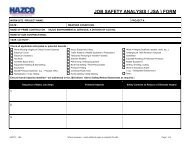International Helicopter Safety Team Safety Management System Toolkit
IHST - Safety Management Toolkit - Skybrary
IHST - Safety Management Toolkit - Skybrary
- No tags were found...
You also want an ePaper? Increase the reach of your titles
YUMPU automatically turns print PDFs into web optimized ePapers that Google loves.
Communication, Awareness<br />
& <strong>Safety</strong> Promotion<br />
Core is defined as “the central or most important<br />
part of something.” Value is defined as “the worth,<br />
importance, or usefulness of something to someone.”<br />
One individual cannot accomplish <strong>Safety</strong> Goals in<br />
an organization. <strong>Safety</strong> is everyone’s responsibility. A<br />
positive safety culture can influence correct behavior.<br />
One of the most effective methods to establish safety<br />
as a core value is to make safety an integral part of<br />
the organization’s management plan. Just as the financial<br />
aspects of organizational management requires<br />
the ability to set goals and assign accountability, so to<br />
does the management of a safety system. Such goals<br />
need to be appropriate, practical and achievable.<br />
They also need to be measurable, dynamic, and fit to<br />
the size of the organization.<br />
For example, a smaller organization may be<br />
expanding into a new line of business or operation.<br />
Some of the issues they may need to consider would<br />
include staffing, employee skill level, hiring, equipment,<br />
impact on existing organization and how all of<br />
these issues would impact safety. A larger organization<br />
would need to consider the same issues. Only the<br />
scope would be different.<br />
The success or failure for meeting safety goals<br />
should be treated like any other goals within the<br />
organization. Requiring safety to be a part of every<br />
management decision underlines the importance of<br />
safety and ensures safety is a normal part of conducting<br />
everyday operations.<br />
<strong>Safety</strong> is recognized as a “core value.” Procedures,<br />
practices, training and the allocation of<br />
resources clearly demonstrate management’s commitment<br />
to safety. The perception that the operation is<br />
most important, no matter the risk, undermines best<br />
safety practice. Effective methods for management to<br />
promote safety include:<br />
Prepare, publish, and disseminate a statement of<br />
management’s commitment to the SMS<br />
Demonstrate commitment to SMS by example<br />
Communicate the outputs of the SMS to<br />
all employees<br />
Provide training commensurate with people’s level<br />
of responsibility<br />
Define competency requirements for individuals in<br />
key positions<br />
Document, review and update training requirements<br />
Share “lessons learned” that promote improvement<br />
of the SMS<br />
Have a safety feedback system with appropriate<br />
levels of confidentiality that promote participation<br />
by all personnel in the identification of hazards<br />
Implement a “Just Culture” process that ensures fairness<br />
and open reporting in dealing with human error<br />
The development of a positive safety culture is<br />
predicated on the involvement of all facets of the<br />
organization. The objective of this requirement therefore,<br />
is to involve all parties in the safety management<br />
system, thereby fostering an organization-wide<br />
commitment to safety management.<br />
<strong>Safety</strong> Culture<br />
Culture influences the values, beliefs and behaviors<br />
that we share with other members of our various<br />
social groups. Culture serves to bind us together as<br />
members of groups and to provide clues as to how<br />
we behave in both normal and unusual situations.<br />
Some people see culture as the “collective programming<br />
of the mind.” Culture is the complex, social<br />
dynamic that sets the rules of the game, or the framework<br />
for all our interpersonal interactions. It is the sum<br />
total of the way people work. Culture provides a<br />
context in which things happen. For safety management,<br />
understanding the culture is an important determinant<br />
of human performance and its limitations. The<br />
ultimate responsibility for safety rests with the management<br />
of the organization.<br />
<strong>Safety</strong> Culture is affected by such factors as:<br />
<strong>Management</strong>’s actions and priorities<br />
Policy and procedure<br />
Supervisory practices<br />
<strong>Safety</strong> planning and goals<br />
Actions in response to unsafe behaviors<br />
Employee training and motivation<br />
Employee involvement or buy-in<br />
Organizational Culture<br />
Organizational culture recognizes and identifies<br />
the behavior and values of particular organizations.<br />
Generally, personnel in the aviation industry enjoy a<br />
68 SMS <strong>Toolkit</strong>







